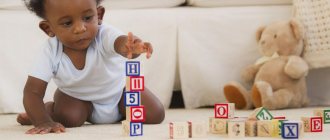1. Why a child may not pronounce the letter “L” 2. How to pronounce the letter “L” 3. Exercises for making the sound “L” at home
- Smile
- Clack like a horse
- Breeze
- Jam
- Reach to the chin
- tube
- Protracted "s"
- Breathing training
- Fine motor skills
4. How to properly conduct classes at home 5. Don’t be afraid to contact a speech therapist again
When children begin to actively master speech skills, they often encounter difficulties in pronunciation. Such difficulties, as a rule, are identified at the age of 4-4.5 years. During this period, children have already mastered most of the sounds, and parents can notice which letters the baby pronounces worse than others.
Most often, the most stubborn letters are “r” and “l”. Both defects are not critical, so parents should not panic. On the contrary, it is important to approach the correction of the defect as carefully and calmly as possible. First of all, you should contact a speech therapist. The specialist will identify the cause of the defect, determine the degree of deviation from the norm and determine a training method that will help the child overcome the obstinate letter.
Today we will talk about why a child may not pronounce the letter “l” and how to make this sound at home.
What mistakes can there be when trying to pronounce “l”?
The most common mistakes when pronouncing the sound “l”:
- lips are positioned incorrectly, which leads to the pronunciation of other sounds;
- the tongue does not touch the palate, but is pulled inside the oral cavity (the sound “y” is obtained);
- When pronouncing the letter “l,” the child inhales sharply.
Usually, children learn to pronounce the sound “r” one of the last. But if its pronunciation is worked out earlier than “l”, a replacement can be made. That is, instead of the word “spoon” the child says “horn”. True, such cases are rarely observed.
Incorrect lip position
When the lips are strongly elongated, at the moment of pronouncing the letter “l” one hears “v” or “u”. In this case, the parent of a preschooler can independently correct the pronunciation of the consonant sound. An exercise in which you need to tightly clench your upper and lower teeth, smile broadly, spreading your lips, is especially helpful.
If the problem in pronouncing the letter “l” is associated with incorrect positioning of the lips, speech therapy exercises for children will help:
- “Fatigue” - inhale deeply through your nose and exhale through your mouth, lips relaxed and slightly open at the moment of breathing.
- “Fish” - clap your relaxed lips, like a fish thrown ashore.
- “Horse” - inhale through your nose, exhale through your mouth, the air passes through relaxed lips with the sound “prr”.
Exercises to stretch the hyoid frenulum
You can quickly master the pronunciation of the letter r using a special set of exercises
One of the causes of speech impairment is a short hyoid frenulum. You can cope with this problem yourself at home or with the help of training with a speech therapist. In severe cases, with severe anomalies, surgical dissection of tissue is prescribed.
The following exercises will help you quickly cope with the problem of incorrect sound pronunciation and stretch the hyoid frenulum:
- Swing. To perform this, the preschooler must open his mouth wide and move his tongue up and down, reaching the teeth with the tip of his tongue. It is recommended to hold your tongue for a few seconds at the top and bottom points. A similar training should be done by moving the tongue to the sides.
- Football. There are two options for performing this task. In the first case, the child should touch the inside of the cheek on the right and left with his tongue, in turn, with light pressure. In the second case, you need to roll a small ball from a bandage and place it behind the child’s cheek, and he pushes the ball out with his tongue.
- Kitty. This exercise will be interesting for children of any age. It is enough to pour a little yogurt or other treat into a plate, which the preschooler should lick with his tongue, imitating the movements of a kitten.
- Reach out. The child should reach with his tongue to the tip of his nose, then to his chin. At the peak, you need to fix your tongue for a few seconds.
When performing exercises to stretch the frenulum of the tongue, parents should not be alarmed by the appearance of a small amount of blood. Its separation with a thin frenulum indicates severe stretching or rupture of tissue. If significant bleeding occurs, consult your pediatrician.
What is lambdacism and paralambdacism?
Incorrect production and automation of the sound “l” or its complete absence is scientifically called lambdacism. It comes in 4 types:
- nasal - during the pronunciation of a sound, the air flow passes not through the oral cavity, but through the nasal cavity (the root of the tongue covers the throat), instead of “l” the sound combinations “ng” are obtained;
- bilabial - the lips are arranged in a tube, the “u” is heard;
- interdental - instead of the upper palate, the tip of the tongue appears in the gap between the teeth;
- complete absence of “l” - this letter is simply missing from the words.
In the practice of speech therapists, another term is known - paralambdacism. This is the replacement of “l” with other sounds. For example, instead of this consonant letter, the child pronounces “b” or “v”, “g”, “d” and others.
Characteristics of the violation
Problems with the reproduction of the sounds “L” and “L” are called lambdacisms. There are several types of violations. With the labial, a distorted sound occurs and something similar to “U” is obtained. With labiodental it turns out “B”. With interdental, the tip of the tongue passes between the teeth.
With dysarthria, softened pronunciation of hard sounds may be observed.
Paralambdacisms are distinguished separately - replacing the sound “L” with “F”, “V”, “U”, “N” and others.
Teaching a child to speak correctly is difficult. Speech therapy adopts a step-by-step approach. Each one achieves certain goals. For successful development, you need the help of your parents. They will do homework with the preschooler.
Formation of correct pronunciation of sounds
In the absence of diseases that are associated with pathologies of the speech apparatus, the pronunciation of the sound “l” can be corrected while performing special speech therapy exercises. They are easy to do at home. In some cases, only a specialist can solve the problem. For dysarthria, which is associated with damage to the nervous system, you will need the help of a neurologist.
Step-by-step home training aimed at correct pronunciation of “l”:
- Strengthening the motor skills of the articulatory apparatus. In this case, special exercises and games will help achieve the desired effect.
- Sound production. Depending on the cause of the defect, a specific method has been developed.
- Accurate pronunciation. Combination of "l" with other letters. First you need to pronounce the syllables, and then the words.
- Poems and tongue twisters for speech development. They will help not only quickly learn the correct pronunciation of sounds, but also develop memory.
At the end, you should consolidate the result obtained by learning songs, fairy tales, and retelling them.
Why doesn't the letter "Ш" hiss?
The speech apparatus and the child’s speech itself require time to develop. If a child uses the sound “sh” for the first time, then imperfect pronunciation is normal. The only thing that needs to be done is to correct the children's skill in time.
- Other possible reasons for incorrect sounding may form a rating in which physiological features will be in first place: the structure of the bite, tongue, palate, diseases of the oral cavity.
- The second point has a direct relationship with the first place: sucking a pacifier for too long. It has long been noted that the bite is sensitive to the presence of the pacifier, and it is hissing and whistling sounds that suffer in speech.
- Parental mistakes can be given an honorable third place. Think about whether you have “wobbled” and “lisped” the child too much, and whether he is trying to imitate your manner of sound pronunciation. Any speech disorders in adults can be the cause of children's speech therapy errors.
Imitation and copying for children are the same ways of learning from the experience of adults as games or directed learning. Watch your own articulation.
- Only in a fifth of cases are we talking about really significant difficulties for two reasons: general underdevelopment, inhibiting the development of speech; impairment of hearing and sound reproduction apparatus.
Preparing for “L” placement exercises
Improving the mobility of the muscles of the tongue and lips is the first step in restoring speech development. Preparation for exercises on placing the “l” is as follows:
- licking the upper lip with the surface of the tongue, moving it from top to bottom and holding the lower lip motionless;
- movements similar to the previous exercise are performed, but at an accelerated pace and with the pronunciation “bl”;
- click the tongue on the upper palate near the teeth, the lower incisors remain motionless, the mouth is slightly open;
- smile widely with your mouth slightly open, count during training: one - the tip of the tongue rests on the upper teeth, two - on the lower teeth (alternately);
- the tongue rests on the palate until the frenulum is tensioned.
These exercises help with any type of incorrect pronunciation of “l”. They must be completed for at least two weeks. According to the recommendations of a speech therapist, the duration of training can be increased to a month.
How to teach a child to say the letter L?
It is better to work with your child in a playful way. For him, doing exercises should not be a burden. When children do them with pleasure, the result is achieved faster.
Before you start doing independent exercises at home, you should sign up for an individual lesson with a speech therapist. The specialist will talk with the child and, based on the conclusions drawn, will develop a technique that will help in a specific situation, and will also give useful recommendations for correcting the pronunciation of “l”.
Basic recommendations and exercises
Each “training” day will need to start with a warm-up.
This is important in order to warm up the child’s articulatory apparatus before performing the exercises. For example, you can ask your baby to “brush” his upper teeth with his tongue
To do this, you need to smile and walk the tip along the inner surface of the row. At the same time, you need to make sure that his jaw remains in place. Another warm-up option can be regular clattering. The fact is that the technique of making the sound characteristic of a horse is somewhat reminiscent of the pronunciation of “R”. And you can laugh with your baby while doing the exercise - who sticks out their tongue further. His trick is to try to say something with this position of the tongue.
It is important to complete all assigned tasks together. The child must see the articulation and facial expressions of the adult, and not just hear
In childhood, the first thing everyone learns is to imitate. The main thing is to be patient, as some exercises can take several months to perform correctly. Under no circumstances should you give up and stop smiling. You really need to treat exercise like a fun game. More precisely, make them like this. And then, after establishing the correct pronunciation of the sound, it will be possible to move on to syllables and simple words. If all the above conditions are met, parents will be able to achieve tangible success with their child. One day, he will easily and simply be able to master continuous speech with a difficult-to-pronounce letter. Don't forget to celebrate this occasion with a delicious cake.
Advertisement
Articulation gymnastics
The main method for correcting the pronunciation of the sound “l” is articulatory gymnastics. As a rule, its duration does not exceed 15-20 minutes; the exact time depends on the age of the child. Articulatory gymnastics consists of step-by-step execution of certain elements that should not only be effective, but also arouse interest in the baby.
Articulation gymnastics includes:
- exercises used to develop speech breathing;
- pronunciation automation tasks.
Exercises to improve speech hearing
To improve a child’s speech hearing, speech therapists use special exercises presented in the form of games:
- “Speak louder and quieter” - depending on the size of the toy being shown, you need to speak loudly or quietly;
- “Find the mistake” - the child is shown a picture, deliberately naming it with mistakes; if the baby notices it, he must clap his hands;
- “Guess whose voice!” − an adult dramatizes the voices of animals, and the child must guess which one belongs to whom;
- “Choose one word!” − the speech therapist shows a picture and lists words, the child must choose the one that matches the image.
To stage the sound “l” step by step, regular training with exercises of varying complexity and music classes are required.
Mimic gymnastics
During facial gymnastics, the entire articulatory apparatus, which is directly involved in the pronunciation of sounds, is trained.
The adult shows the pictures and says what is shown on them, and the child plays with facial expressions:
- “Here is a little fox. And this is an adult moose. Look how much he has grown” - the baby should show surprise;
- “The cat was given milk, he laps it up. And Polina is smiling sweetly on the side” - the child must show how the cat drinks milk and the girl’s smile;
- “Little Masha was crying, she lost her porridge” - the baby shows how the girl cries.
Mimic gymnastics also includes exercises with a small ball with a cord threaded through it:
- catch the ball with your mouth without using your hands;
- push the ball with your tongue;
- push out with your lips, making some effort;
- pronounce tongue twisters with a ball in your mouth.
Another type of facial exercise is using a spoon:
- take a small spoon into your fist, place it in your mouth and push with your tongue, try to turn it in different directions;
- lightly tap the tongue with a spoon;
- Use a spoon to outline the oval of your lips, having previously folded them into a tube.
Breathing exercises
To make the sound “l”, breathing exercises are performed, which includes two main exercises:
- short breath for 1 second;
- long, slow exhalation for 3 or 5 seconds.
A few more exercises from the breathing exercises complex:
- inhale, relax your lips and slowly release air through them with the sound “prr”;
- lie on the floor, place your hands on your stomach, inhale, inflating your stomach, exhale - your stomach has decreased in size;
- The adult gives the child a sniff of something from the food, he inhales, and at the exit names the product.
Simple breathing exercises in combination with other methods can make the sound “l”.
How to make correct pronunciation automatic?
Making the sound “l” at home is not always a simple task. Sometimes this takes a lot of time, and sometimes you can’t do it without the help of a specialist.
The main thing is to avoid overload, because for a child even 40 minutes of studying a day may seem like hard work. Workouts should be fun and relaxed, making them easier to handle if they are treated as play rather than work. It is enough to conduct 2 classes daily for a few minutes each.
Soft "l"
What is noteworthy is that even after a child learns to pronounce the sound “l”, he can continue to omit it in words. In this case, you need to produce a soft sound - “l”. It is advisable to start training first with syllables and only then move on to full words (le - swan, lyu - cradle).
Pure sayings like “li-li-li – we found mushrooms” and others are useful. Tongue twisters will also be useful:
- “At the warm stove, Anatoly is weaving bast shoes”;
- “Little Valentine boots for the giant”;
- “Lala was eating halva under the blanket.”
When straight syllables with a soft “l” are obtained, it is worth moving on to the next stage of learning - the pronunciation of reverse syllables, such as “ul”, “al” and others. Next - pronouncing words - moth, poplar, tulip and others.
When placing a soft “l”, you need to ensure that the tongue is positioned correctly in the mouth.
Hard "l"
According to speech therapists, the production of the sound “l” from “l” is characterized by increased complexity. Teaching a child to say a solid letter is somewhat more difficult and takes longer. However, the technique does not abandon the previous one, it just requires more repetitions.
It is advisable to start with the syllables “la”, “lu”, “lo” and others. Then you can move on to the words: “bow”, “boat” and others.
And this is where tongue twisters and pure tongue twisters come in handy:
- “Lu-lu-lu - sweep up the ashes”;
- “Volodka is in the boat.”
When learning to pronounce hard and soft “l”, you should avoid words with the letter “r”, as the child may get confused.
4 How to properly conduct classes at home
We have already noted that the best way to teach something to a child 4-5 years old and a little older is through play. Therefore, you should not persist too much and turn speech therapy at home into torment. Everything should happen as if by itself.
At the initial stages, such exercises should be performed no more than 1-2 times a day, after which they can be increased to 3-4.
Be sure to show everything by your own example. Remember that you are the most important person for your baby. Mentor, friend and assistant all rolled into one.
Don’t forget to praise and enjoy your child’s progress, and don’t scold him if something doesn’t work out for him. This way you can discourage him from wanting to study. In addition, do not be afraid to explain to your son or daughter why and why you are doing all this. The child must realize that mom and dad always act solely in his interests.
Help from a speech therapist
Up to 5 years of age, incorrect pronunciation of certain sounds is considered normal. But in the sixth year of life, the baby already needs the help of specialists. First, you can try to correct the situation at home; if you cannot cope on your own, you should contact a speech therapist.
The first speech therapy session will help determine the cause of the incorrect pronunciation of the sound. This will help develop an effective technique that is suitable for a particular child. In some cases, assistance from other specialists may be required.
Sometimes a mechanical method of producing the sound “l” is used - using probe No. 4.
Age characteristics
The formation of language skills occurs in several stages, so parents should know what speech skills a child should have at a certain age in order to consult with a specialist in time in case of problems.
Stages of speech development:
The first year of life - at 1.5 months, the baby makes vowel sounds (“a”, “u”, “s”). At this time, the formation of the intonation system occurs. At six months the baby begins to babble and even pronounce certain syllables (“ma”, “ba”, “dya”), and by 12 months he is already trying to speak basic words. The function of speech understanding is formed precisely during this period, and after that the process of vocabulary replenishment begins. By the way, the first thing the baby says is not “mom,” as many people think, but “give.” According to statistics, this is typical for 60% of children.
- The second year - during this period the baby begins to understand the speech of adults well. He listens carefully to what others say to him and tries to repeat some words after them. The baby is already talking, but only in his own language. These words are incomprehensible to adults, but parents eventually learn to recognize the baby’s peculiar speech. You can teach a child to talk at 1.5 years old by repeating the same words over and over again, and by the age of 2 years the baby will already be able to pronounce individual phrases (“Mom, give me”, “I want yum-yum”, etc.).
- Third year - at this age, noticeable progress appears in the development of verbal skills. The child begins to form sentences and can engage in meaningful dialogue. During this period, you should try to read to your baby as much as possible, sing songs with him and constantly communicate.
Games to strengthen pronunciation
After a long learning process, the final stage follows - consolidating the pronunciation of the sound “l”.
In this case, the following games will help:
- come up with about 30 small sentences, each word of which must contain the letter “l” (The doctor is treating Lola, Leaves are flying on the windshield), you should pronounce them together with the child, gradually accelerating the pace;
- invite the child to complete a phrase like “My sister paints her nails not with paint, but with ... (varnish)”, “The house became dark because they turned off ... (the lamp), the last word of the phrase must contain “l.”
At the final stage, when consolidating the pronunciation of the sound “l,” tongue twisters and tongue twisters also help. When the child begins to pronounce them correctly, clearly pronouncing each sound, you can begin to study poems.











